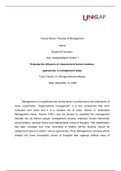Course Name: Theories of Management
Name:
Student ID Number:
Title: ASSESSMENT POINT 1
Evaluate the influence of classical and human relations
approaches in management today
Tutor’s Name: Dr. Attridge Mwelwa Mwape
Date: December 13, 2020
Management is a significant and central factor in performance and productivity of
every organization. Organizational management is a key perspective that were
evaluated over years and it is a complex era of study. Hence, to understand
Management theory, Koontz (1961) was the pioneer to classified the management
theories into six distinct groups: management process, empirical, human behavioral,
social systems, decision theory and mathematical school of thoughts. This classification
has been changed over time. According to Mullins (2016), theories should be
categorized based on writers’ various approaches. Thus, Management concepts will be
divided into three perceptible school of thoughts that organize definite ways of
,managerial practices. Principally, this classification categorized into Classical, Neo-
Classical and modern management theories. Classical theories spotlight the
managerial, scientific and bureaucracy approaches while Neo-Classical focus on
behavioral features and human relations. Further, the modern theories concentrate on
all essentials of organization through system and contingency approaches. The
following paper discuss the journey of management progress over time and illustrate
some of the eminent theorists works and their fundamental concepts. Subsequently, this
paper will present Johnson and Johnson as a case study to demystify in depth the
influence of Classical and Human relations approaches in the present-day
management.
Classical management theory (l880s-1920s)
The classical theory is based on the structural concept of administration,
regardless of its framework. Ferdous (2017), argued that classical theory of organization
formed following fundamental supports: division of labor, functional and scalar
procedures, structure and range of control. Moreover, Mullins (2016) portrayed four
main emphasis of classical theory are pivoted around planning of work, technical
requirements, principles of management and assumption of rational and logical
behavior. First assumption about this theory might be that managers just focus on
productivity and monetary desires and have a pessimistic view about human character
(Sridhar,2016). But, classical theory, in fact, recognized the human’s emotion in rational
and logical framework but they were unaware of human behavioral (Mullins, 2016,
p.41). Nonetheless, it should be noted that these theories were created by the time of
industrial reorganization and appearance of mass production and complex
organizations with new technologies. Practically, classical theory is associated with
work of various thinkers in the last century such as: Taylor, Fayol, Urwick, Webber,
Mooney, Luther Gulik, Brech and Reiley (Mullins, 2016, p.37-39).
Fredrick Winslow Taylor (1856-1915), an American mechanical Engineer, was
pioneer to introduce scientific methods in classical management during last decade of
, 19th century. His practical theory was based on his experiences in three different steel
companies. Taylor focus on the content of a ‘fair day’s work’ (Mullins, 2016, p. 39) and
enhance the level of productivity by eliminating the workplace inefficiency and discard
the traditional method of trial- error and rule of thumb. Significantly, the scientific
process involved experiments, observations and analysis due to maximize worker’s
productivity (Parker & Ritson, 2005). A major obstacle that Taylor observed was
‘systematic soldiering’ which illustrate the intentional attempts of workers to increase
their remunerate while ignoring the piece- rate work (Mullins, 2016, p. 39). Taylorism
follows several key principles:
Division of responsibility
Development of science for each element
Close Cooperation between workers and management
Scientific selection, training and development.
Mental revolution
Maximum prosperity for employers and employees.
Concerning this issue, Taylor imply different techniques such as time and motion study,
standardisation, functional foremanship and supervision of workers. Taylor followers
were Henry Gantt, Frank and Lillian Gilberth and Harrington Emerson (Kitana,
2016). According to Drucker, Taylor’s work was not focused on inefficiency but try to
replace industrial dispute with industrial harmony (Mullins, 2016, p.40). His theory has
both advantages and disadvantages. Some of the strength spots in Taylorism are:
higher productivity with reduction in cost and effectiveness utilisation of resource,
division of labour, increased prosperity and rewards for efficiency. Nevertheless,
Taylorism overlook the human side and treat workers as a machine. Also, on the
authority of Rahman (2012), specialisation, over-simplification and close supervision
caused the boredom, depression and monotony of workers.
Henry Fayol (1841-1925), a French mining engineer, was the father of modern
management. His theory was based on his work experience in Coal and Iron company.




